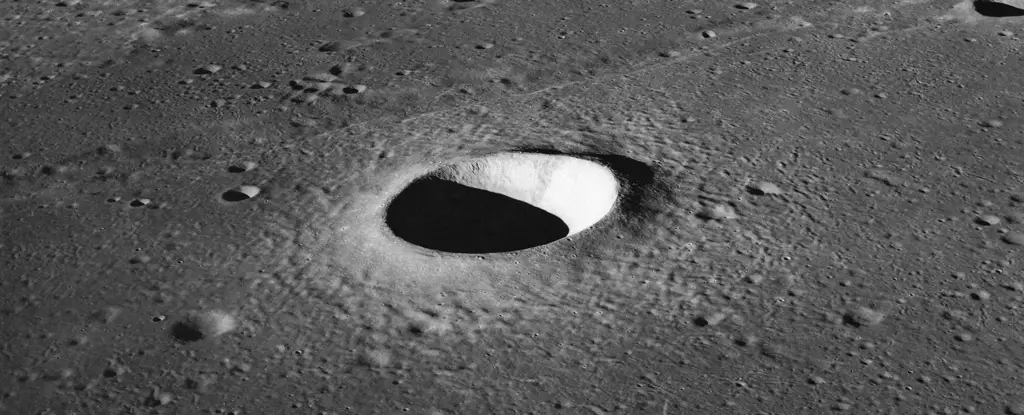The Moon’s surface is an ancient tapestry of impact craters, each telling a story of violent encounters with celestial bodies that have shaped our solar system’s evolution. From minuscule pockmarks to sprawling basins over 1,000 kilometers wide, these craters are relics of an era known as the Late Heavy Bombardment, which occurred around 4 billion years ago. During this time, the inner solar system faced a barrage of asteroids and comets that left indelible marks on the lunar surface. Unlike Earth, where the incessant dance of weather, erosion, and tectonic activity continuously alters the landscape, the Moon remains a preserved canvas, allowing these craters to endure through the ages. This stagnant geological state provides an unparalleled opportunity for scientists to delve into the history of cosmic collisions that forged our celestial neighborhood.
Material Transfer: A Tantalizing Interaction
While the Moon may seem isolated in the fabric of space, it is not entirely alone. A significant amount of lunar material, launched into space during impacts, reaches Earth at astonishing speeds. The interplay of gravitational forces and impact dynamics causes ejected lunar debris to attain escape velocity, paving the way for a fascinating exchange between our planet and its satellite. Understanding this process is crucial, especially for researchers curious about how lunar rocks contribute to Earth’s geological makeup and evolution.
Recent research, spearheaded by a team led by Jose Daniel Castro-Cisneros, has focused on this very interaction, using advanced computational simulations to track how moon debris finds its way to Earth. Utilizing improved computer models, the team sought to evaluate a wider range of initial conditions and extend the time frame of their observations. This fresh perspective intends to quantify the amount of lunar material that impacts Earth and contributes to our understanding of near-Earth objects, a category that includes intriguing entities like Kamo’oalewa, a suspected lunar fragment orbiting close to our planet.
Simulating the Cosmic Ballet
The team’s innovative approach hinged on the REBOUND simulation package, which allowed them to observe lunar particles for a staggering 100,000 years. By concurrently modeling the Moon and Earth with a more accurate distribution of ejection velocities, the researchers gained deeper insights into the dynamics of lunar ejecta. They meticulously recorded data every five years, focusing on collision events where material reached at least 100 kilometers above Earth’s surface. This method provided a more nuanced understanding of how lunar fragments traverse the void and eventually make contact with our home planet.
The analysis revealed some compelling statistics: approximately 22.6% of the material launched from the Moon reaches Earth within the first 100,000 years following an impact. Moreover, half of these collisions occur in the initial 10,000-year period, underscoring the urgency of this cosmic exchange. The study also identified a power-law distribution governing the collision rate over time, highlighting an intriguing relationship between the size of impact events and their resultant fragments.
Cosmic Insights into Impact Patterns
The study’s revelations extend beyond simple statistics; they uncover the nuances of impact trajectories, with significant implications for the understanding of the Earth-Moon system. Interestingly, the study found that lunar material launched from the Moon’s trailing side has the highest probability of colliding with Earth, while the leading side produces the fewest impacts. This finding shifts our perspective on the geometry of lunar strikes and their resulting ejecta trajectories.
Moreover, the identified impact rates suggest that lunar ejecta predominantly reach Earth with velocities ranging from 11.0 to 13.1 kilometers per second, with a distinct prevalence of impacts around the equator. The data also illustrated a surprisingly uniform distribution of strikes between day and night, informing us that these collisions peak around 6 AM and PM. Such discoveries challenge long-held assumptions about where and when lunar remnants are likely to bedevil Earth, enhancing the complexity of our understanding of these celestial interactions.
Enduring Legacy and Future Explorations
The findings from Castro-Cisneros’s team not only illuminate the intricate relationship between the Earth and the Moon but also cement the lunar origin hypothesis for objects like Kamo’oalewa. The study enriches our awareness of the shared history etched into our cosmic neighborhood, providing a framework for future explorations that may further define the boundaries of our interaction with the Moon. As scientific understanding evolves and technology advances, the insights gained from this research will undoubtedly guide future endeavors in lunar studies, potentially unlocking even more of the Moon’s enigmatic past.

